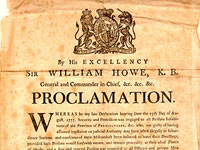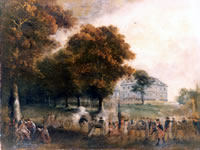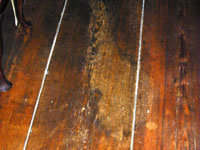Germantown Philadelphia, PA USA |
Images
QTVR
**NOTE**Many of the QuickTime panoramas available for viewing here contain embedded links to adjacent rooms. Please note that these do not work, as the QTVR images have been extracted unaltered from the full virtual tour package.
Cliveden - DINING ROOM 104
Tour the QTVR - (~2.4mb please be very patient, and enable pop-ups)
© 2002 Learning Sites, Inc.
(Clip from the audio file)
The door you see on the left goes to the kitchen. My father had a walkway built to connect the Kitchen to the Dining room. On the opposite wall you will see the large fireplace used to heat this room. Around the table there are painted "fancy chairs" made during the early 1800s when I owned the house. Now go back into the Hall and click on the Parlor door.
Deshler-Morris House - TEA ROOM 105
Tour the QTVR - (~550kb please be patient, and enable pop-ups)
© 2002 Learning Sites, Inc.
(Clip from the audio file)
Martha Washington used this small, bright corner room off the garden for serving tea. Different cakes and pastries or fruit would have been served on fine Chinese plates with the best silverware. Look at the corner china cabinet. The red paint inside it shows off the expensive blue and white dishes. Mr. Deshler sold this type of paint in his hardware store. Look at the Dutch tile border of the fireplace. Mr. Deshler probably brought these tiles from Holland.
Deshler-Morris House - KITCHEN 107
Tour the QTVR - (~505kb please be patient, and enable pop-ups)
© 2002 Learning Sites, Inc.
(Clip from the audio file)
When this was only a summer cottage, everyone cooked and ate in this room. After the new dining room was added, this became simply the kitchen. Look at the wide, deep fireplace built for cooking. When Washington and his grandchildren lived here, their cook Hercules, a slave, prepared their meals. The family affectionately called him "Uncle". The President respected his cooking talents and his timely, organized rule over the kitchen, especially when guests were invited to the house.
Three years later, in 1797, on the Washington family’s last day in Philadelphia before returning to Mount Vernon, Hercules fled from Washington’s household to seek his freedom. He probably found protection through people in Philadelphia who helped slaves to freedom. Pennsylvania had a law against slavery by 1780. Other states, such as Virginia where Washington lived, did not. Despite Pennsylvania’s law, in the year 1800 there were 85 slaves in Philadelphia and 1,706 remaining in the state.
Grumblethorpe - MAIN PARLOR 102
Tour the QTVR - (~2.1mb please be patient, and enable pop-ups)
© 2002 Learning Sites, Inc.
(Clip from the audio file)
Welcome to John Wister’s large room for visitors. Circle your cursor all around to get a full view. Look at the fine tables, chairs, and mirror. Philadelphia craftsmen made these delicate pieces by hand around 1750. That makes them over 250 years old. The grandfather clock was called a tall case clock in my time. It was made in London about the same time. See how many clocks of any kind you can find in my house.
In this room the family sat in front of the large corner fireplace. It has a twin in the dining room next door. The early Swedish settlers brought the idea of corner fireplaces with them to America. Now look up at the ceiling. You will see the edge of a large circular ring raised from the flat ceiling. We called this the "wedding band ceiling" because of its shape. The floor is made of beautiful, wide oak boards. These came from trees cut down in the woods behind Mr. Wister’s house. Stains on these floorboards tell the tale of the American Revolution in Germantown.
General Howe and his British forces had moved into Germantown by October 3rd, 1777. General Washington was lying low with his soldiers in fields and farms to the west. General Howe took over Mr. Deshler’s House just up the road. General James Agnew of Scotland took Mr. Wister’s Big House as his headquarters. My family was either in Philadelphia or farther out in the country.
The morning of October 4th, General Agnew left this house by horse for the battle as General Washington’s troops began to attack. As Agnew rode up a hill into the town, a party of 100 Americans attacked them. His aide wrote that General Agnew wheel’d round and putting spurs in his horse and calling to me, receiv’d a whole volley from the Enemy, the fatal ball entered the small of his back near the back seam of his coat, right side, and came out a little below his left breast. Another ball went through and through his right Hand. I at the same time received a slight wound in the side but just got off time enough to prevent his falling. With the assistance of two men we took him down, carried him into a house, laid him on a bed . . . where he departed this life between 10 and 11 o’clock. I then had his body brought to his former quarters. . and had a coffin made.
My family spent years trying to scrub out the bloodstains left as Agnew’s body was brought back into the house. You can still see the stains under the rug. Click on the floor to the right of the exterior front door to see it.
Grumblethorpe - MASTER BEDCHAMBER 204
Tour the QTVR - (~2.5mb please be patient, and enable pop-ups)
© 2002 Learning Sites, Inc.
(Clip from the audio file)
This is the master bedchamber. John Wister, the builder of the house was the first to use it. He had three wives, but only two lived to use this room. Only four of his nine children grew to be adults. John’s third wife was Anna Thomin, or Sister Anastasia, from Switzerland. In 1771 he helped her escape by carriage from a religious community in Ephrata outside Lancaster and they married in Philadelphia.
The furniture includes a Philadelphia-made tall-post bed with heavy winter curtains and a chest-on-chest. On the round table is a portable writing desk. Bathrooms did not exist in early houses, and in this room you see a corner washstand and a bowl and pitcher on a small bureau for washing up. Next to the cradle is an infant’s washbasin and by the fireplace a large metal bathing tub. All the water would have been heated in the kitchen and then carried upstairs for a bath.
After John Wister died in 1781, his son Daniel and his wife Lowry Jones, a Quaker, owned this house. Their daughter Sally took over the next bedroom.
The entire package can run on either PC or Apple-Mac computers.
Need a QTVR plugin? QuickTime or DevalVR
Reference
Page Created: October 5, 2004
Page Updated: November 4, 2009
URL:
Page Author: The Institute for the Visualization of History


